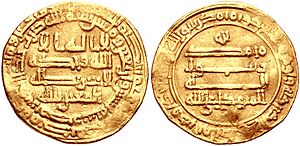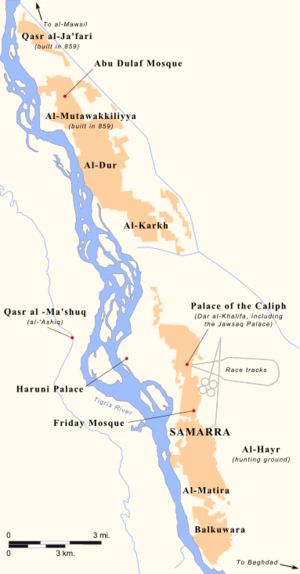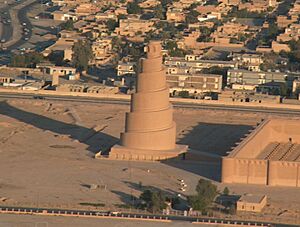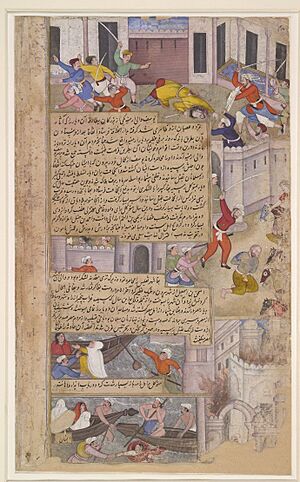Al-Mutawakkil facts for kids
Quick facts for kids al-Mutawakkilالمتوكل |
|||||
|---|---|---|---|---|---|
|
|||||
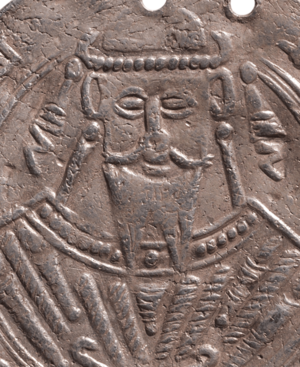
Bust of al-Mutawakkil on a silver dirham
|
|||||
| 10th Caliph of the Abbasid Caliphate | |||||
| Reign | 10 August 847 – 10 December 861 | ||||
| Predecessor | al-Wathiq | ||||
| Successor | al-Muntasir | ||||
| Born | 31 March 822 Baghdad, Abbasid Empire |
||||
| Died | 11 December 861 (aged 39) Samarra, Abbasid Empire |
||||
| Burial | Samarra | ||||
| Consort |
List
|
||||
| Issue |
|
||||
|
|||||
| Dynasty | Abbasid | ||||
| Father | al-Mu'tasim | ||||
| Mother | Shuja | ||||
| Religion | Sunni Islam | ||||
Al-Mutawakkil (born Ja'far ibn Muhammad ibn Harun, March 822 – December 11, 861) was the tenth Abbasid caliph. He ruled from 847 until he was assassinated in 861. His full name, al-Mutawakkil ʿalā Allāh, means "He who relies on God."
He took over from his brother, al-Wathiq, and is known for making the Abbasid Empire as large as it ever was. Al-Mutawakkil was a very religious leader. He stopped the persecution of Islamic scholars and released Ahmad ibn Hanbal from prison. He was also known for being strict, especially with people who were not Muslim.
Al-Mutawakkil was killed on December 11, 861, by his Turkic guards. His own son, al-Muntasir, supported this act. His death started a difficult time of civil unrest known as the "Anarchy at Samarra."
Contents
Early Life of Al-Mutawakkil
Al-Mutawakkil was born on March 31, 822. His father was Prince Abu Ishaq Muhammad, who later became Caliph al-Mu'tasim. His mother was a slave from Khwarazm named Shuja. We don't know much about his early life. He didn't play a big role in politics until his older half-brother, al-Wathiq, died in August 847.
He was born during the rule of his uncle, Caliph al-Ma'mun. Al-Mutawakkil's full name was Ja'far ibn Muhammad. His early life was during a time often called the golden age of the Abbasid Caliphate. His father became the eighth Abbasid caliph in 833 and ruled for eight years. His elder son, al-Wathiq, then became caliph.
As a young prince, Ja'far's first son, Muhammad (who would become al-Muntasir), was born in 837. Muhammad's mother was Hubshiya, a Greek woman. Ja'far was 14 years old when his first son was born. His other sons, Ahmad (later al-Mu'tamid) and Talha (later al-Muwaffaq), were born in 842 and 843.
In 842, Ja'far led the pilgrims to Mecca. His brother al-Wathiq's mother, Qaratis, also went on the pilgrimage but died during the journey. Ja'far remained a courtier, meaning he served in the caliph's court, during his brother's rule.
Al-Mutawakkil Becomes Caliph
Al-Wathiq's death was sudden, and he hadn't chosen who would rule after him. So, important officials like the vizier (a high-ranking minister) Muhammad ibn al-Zayyat and Turkish generals met to decide. They chose the 26-year-old Ja'far, who became Caliph al-Mutawakkil. The officials hoped he would be easy to control, like al-Wathiq.
However, al-Mutawakkil wanted to bring back the power of the caliph. He planned to remove the officials who had too much control over the government.
Al-Mutawakkil's first target was the vizier, Ibn al-Zayyat. Al-Mutawakkil held a grudge against him for past disrespect. One time, when al-Wathiq was angry with al-Mutawakkil, the prince went to the vizier for help. But Ibn al-Zayyat made him wait and then mocked him. He even complained to the caliph about al-Mutawakkil's clothes and long hair. As a result, al-Wathiq had al-Mutawakkil's hair cut off and hit him in the face with it. This public humiliation deeply upset al-Mutawakkil. So, in September 847, he had Ibn al-Zayyat arrested. The vizier's belongings were taken, and he died in prison.
Another powerful figure was Itakh, a Turkish general. He held many important positions. But in 848, al-Mutawakkil tricked him into going on a pilgrimage. When Itakh returned, he was arrested. His wealth was taken, and he died in prison in 849.
Al-Mutawakkil also released the famous Islamic scholar Ahmad ibn Hanbal from prison. Ahmad ibn Hanbal had been imprisoned by previous caliphs for his beliefs about the Quran. Al-Mutawakkil ended this persecution, known as the Mihna.
In 850, al-Mutawakkil issued a rule for Christians and Jews in his empire. They had to wear yellow clothes and belts so people could tell them apart from Muslims.
In 851–852, Armenians rebelled against the Abbasid governor. Al-Mutawakkil sent his general, Bugha al-Kabir, to stop the rebellion. Bugha was successful. He attacked and burned Tiflis and captured the rebel leader, who was later executed.
In 854–855, there were revolts in Homs. Al-Mutawakkil had these uprisings stopped strongly. Because Christians had joined in some of the unrest, the caliph had Christians removed from Homs.
In 855, the Beja people in Upper Egypt stopped paying taxes on their gold mines. They also drove out Muslims working in the mines. Al-Mutawakkil sent a general named al-Qummi to fix the problem. Al-Qummi managed to retake the mines and defeat the Beja king. The Beja then started paying their taxes again.
Al-Mutawakkil's rule is remembered for its many changes and is seen as a golden age for the Abbasids. He was the last great Abbasid caliph. After his death, the empire began to decline.
Religious Policies
Al-Mutawakkil decided to change the religious policies of earlier caliphs. He wanted to end the debate about whether the Quran was created or not. This brought an end to a period of strict religious rules that had been in place since 833.
He took strong actions against the Mu'tazilites, who had different religious views. He removed many of their judges and stopped debates about the nature of the Quran.
The caliph also tried to make peace with Ahmad ibn Hanbal. In March 852, he ordered that all prisoners held because of the Inquisition (the mihna) be released. This largely ended that difficult period.
In 850, al-Mutawakkil made a rule for Dhimmi (Christians and Jews). They had to wear special clothes to tell them apart from Muslims. Their places of worship were to be destroyed, and they were not allowed to have many government jobs.
Al-Mutawakkil also ordered the ancient sacred Cypress of Zoroastrians, the Cypress of Kashmar, to be cut down. He wanted to use its wood for his new palace. This caused huge protests from the Zoroastrian community. The cypress was over 1400 years old and was very important to them. Al-Mutawakkil was killed before the wood arrived for his palace.
Al-Mutawakkil's Achievements
Al-Mutawakkil was different from his brother and father. He wasn't known for loving knowledge, but he loved grand buildings. The Great Mosque of Samarra was the largest mosque in the world at that time. Its minaret is a huge spiral cone, 55 meters high, with a ramp that spirals up. The mosque had 17 aisles, and its walls were decorated with dark blue glass mosaics.
The Great Mosque was part of a larger expansion of Samarra. Al-Mutawakkil built as many as 20 palaces. Samarra became one of the largest cities in the ancient world. Even today, its ruins are very extensive.
In 859–860, the caliph started building a new city called al-Ja'fariyya on the Tigris River, about eighteen kilometers from Samarra. Al-Mutawakkil ordered a canal to be built to bring water from the Tigris. He gave this job to two courtiers, who then gave the work to al-Farghanī, a famous astronomer. Al-Farghanī made a mistake in his calculations, and it looked like the canal would only get water when the river was almost flooding.
News of this mistake reached the caliph. The engineer, Sind ibn 'Alī, bravely promised that the project would work, saving everyone involved. Al-Mutawakkil was assassinated shortly before the mistake became public.
Al-Mutawakkil was very involved in religious discussions. This showed in his actions against different groups. His father had tolerated the Shī'a Imām in Medina. For the first few years of his rule, al-Mutawakkil continued this policy. However, as Imām 'Alī al-Hadī became more famous, the Governor of Medina suggested that a rebellion was being planned. Al-Mutawakkil invited the Imām to Samarra, an offer he couldn't refuse. In Samarra, the Imām was kept under house arrest and watched closely. No reason to act against him ever appeared. After al-Mutawakkil's death, his successor had the Imām poisoned. The general Shī'a population faced harsh treatment. This included the destruction of the shrine of Hussayn ibn 'Alī, which was done to stop pilgrimages to that site.
Al-Mutawakkil planned for his three sons to become caliph after him. First, his eldest son, al-Muntasir, then al-Mu'tazz, and third, al-Mu'ayyad.
During his reign, al-Mutawakkil also met the famous Byzantine scholar Cyril the Philosopher. Cyril was sent to improve relations between the Byzantine Empire and the Caliphate.
Family Life
Al-Mutawakkil had many wives and concubines. One of his wives was Farida. She was a singer who belonged to his brother al-Wathiq's household. After al-Wathiq died, she was given to al-Mutawakkil, who married her. Another wife was Sa'anin, who was Christian and the daughter of a monk. Al-Mutawakkil met her at a monastery and was charmed by her. She converted to Islam and became his favorite until his death.
He had many concubines, and some of them were mothers to his sons. Hubshiya was a Greek woman and the mother of his eldest son, al-Muntasir. After her son died, she built a public tomb for him in Samarra. This made him the first Abbasid caliph whose burial place was not kept secret.
Another concubine was Ashar, also known as Umm Ishaq. She was from Andalusia and was one of his favorites. She was the mother of his sons Ibrahim al-Mu'ayyad and Abu Ahmad al-Muwaffaq. Fityan, from Kufa, was the mother of Caliph al-Mu'tamid. Qabiha, a Greek woman, was the mother of Caliph al-Mu'tazz. She was known for her poetry and beauty.
Shajar was a concubine whom al-Mutawakkil loved very much. She was his favorite. On one occasion, she gave him a gift of twenty gazelles with Chinese saddles, each carrying bags of precious scents. His other concubines became jealous and plotted to kill her with a poisoned drink, which led to her death.
Death of Al-Mutawakkil

Al-Mutawakkil continued to rely on Turkic officials and soldiers to stop rebellions and fight foreign empires. His secretary, al-Fath ibn Khaqan, was a famous Turkic figure of his time. However, his reliance on Turkic soldiers eventually led to his downfall. Al-Mutawakkil had his Turkic commander-in-chief killed. This, along with his harsh policies towards the Shia, made him quickly lose popularity.
Al-Mutawakkil had named his oldest son, al-Muntasir, as his heir in 849/50. But he slowly started to favor his second son, al-Mu'tazz, encouraged by al-Fath ibn Khaqan and the vizier Ubayd Allah ibn Yahya ibn Khaqan. This created a rivalry between the brothers. Al-Muntasir was supported by the Turkic guards, while al-Mu'tazz had the backing of traditional Abbasid leaders.
In late 861, things became very tense. In October, al-Mutawakkil ordered the lands of the Turkic general Wasif to be taken and given to al-Fath. Feeling trapped, the Turkic leaders began to plan the caliph's assassination. Al-Muntasir also joined them, or at least approved, because he felt humiliated by his father. For example, he was not allowed to lead the Friday prayer, and his father even slapped him. With rumors that Wasif and other Turkish leaders would be executed, the plotters decided to act.
On the night of December 10/11, the Turks burst into the room where the Caliph and al-Fath were eating. Al-Fath was killed trying to protect the Caliph, who was then also killed. Al-Muntasir immediately became caliph. At first, he claimed that al-Fath had murdered his father and was then killed. But soon, the official story changed to al-Mutawakkil choking on his drink. The murder of al-Mutawakkil started a chaotic period known as the "Anarchy at Samarra," which lasted until 870. This period almost caused the Abbasid Caliphate to collapse.
Legacy of Al-Mutawakkil
Al-Mutawakkil's time as Caliph is remembered for its many changes and is seen as a golden age for the Abbasids. He was the last great Abbasid caliph. After his death, the dynasty began to decline. The Caliphate, which had been built by earlier leaders, also lost its power as a world force.
Many scholars of his time praised al-Mutawakkil. The famous scholar al-Taymi said:
There were three great caliphs: Abu Bakr, who fought the Apostates until they surrendered; Umar ibn Abd al-Aziz, who made good the abuse of Umayyads and al-Mutawakkil, who abolished heretical innovations and publicly proclaimed Sunnah
Ali ibn al-Jahm said:
The Caliph al-Mutawakkil sent for me and said, "Ali, I dreamed I saw the Prophet. I rose to greet him, and he said, 'You're rising for me even though you're a caliph?'" "It's a good dream, Commander of the Faithful," I said. "Your rising for him symbolizes your standing up for the sunnah. And he called you caliph"
Ali ibn Ismail said:
In Tarsus I dreamed that I saw al-Mutawakkil sitting in a place full of light.
Al-Mutawakkil had named his three sons as heirs: al-Muntasir first, al-Mu'tazz second, and al-Mu'ayyad third. Al-Muntasir became caliph on December 11, 861, after his father was killed. He quickly took control and received support from important state leaders. His short rule lasted less than half a year. During his reign, the Turkic leaders pressured him to remove al-Mu'tazz and al-Mu'ayyad from the line of succession.
When al-Muntasir died, the Turkic officers chose his cousin al-Musta'in to be the new caliph. Al-Musta'in faced a large riot in Samarra from people who supported al-Mu'tazz. The rioters were stopped by the military, but many people were hurt. Al-Musta'in, worried about his cousins, first tried to pay them off and then put them in prison. In 866, al-Musta'in was killed by his nephew al-Mu'tazz.
Al-Mu'tazz's rule showed how much the central power of the Caliphate was weakening. He was unable to pay the Turkic troops, and in July 869, a palace coup removed him from power. He was imprisoned and treated so badly that he died three days later. He was followed by his cousin, al-Muhtadi, who ruled until 870. Al-Muhtadi was also murdered and replaced by his cousin, al-Mu'tamid, who ruled from 870 to 892.
Images for kids
-
Bust of al-Mutawakkil on a silver dirham
-
Abbasid Caliphate at its greatest extent around 850, during al-Mutawakkil's rule. The Abbasid Caliphate completed its 100 years during his reign.
See also
 In Spanish: Al-Mutawákkil para niños
In Spanish: Al-Mutawákkil para niños


